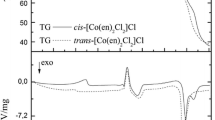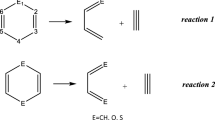Abstract
The aqueous reactions H++OH−=H2O at 325°C and Na++OH−= NaOH(aq) at 250–325°C, were studied using a flow calorimeter. Heats of mixing of aqueous NaOH and HCl solutions were measured at 325°C. The enthalpy of water formation (ΔH=95.9 kJ-mol−1, valid at 12.4 MPa and infinite dilution) was obtained at this temperature from the heat of mixing data but differs significantly from that calculated from the Marshall-Franck equation. This calorimetric ΔH at 325°C was used in combination with literaturelog K and ΔH values at lower temperatures to derive equations representinglog K, ΔH, ΔS, and ΔCp for the formation of water from 250 to 325°C. Heats of dilution of aqueous NaOH solutions were measured at 250, 275, 300, and 325°C. Log K, ΔH, and ΔS for the formation of NaOH(aq) were determined at these temperatures from the fits of the calculated and measured heats while ΔCp values were calculated from the variation of ΔH with temperature. No previous experimental results have been reported for the formation of NaOH(aq). The isocoulombic reaction principle is tested using thelog K values obtained in this study. The plot oflog K vs. 1/T for the isocoulombic reaction NaOH(aq) +H+=H2O+Na+ is approximately linear.
Similar content being viewed by others
References
A. A. Noyes,The Electrical Conductivity of Aqueous Solutions (Carnegie Institute of Washington, Pub. No. 63, 1907).
A. A. Noyes, Y. Kato, and R.B. Sosman,J. Am. Chem. Soc. 32, 159 (1910).
H. S. Harned and B. B. Owen,Physical Chemistry of Electrolytic Solutions, 3rd edn., (Reinhold, New York, 1958).
F. H. Sweeton, R. E. Mesmer, and C. F. Baes, Jr.,J. Solution Chem. 3, 191 (1974).
W. L. Marshall and E. U. Franck,J. Phys. Chem. Ref. Data 10, 295 (1981).
G. Olofsson and I. Olofsson,J. Chem. Thermodyn. 5, 533 (1973).
G. Olofsson and L. G. Hepler,J. Solution Chem. 4, 127 (1975).
L. G. Sillen and A. E. Martell,Stability Constants of Metal-Ion Complexes (The Chemical Society, Burlington, London, 1964).
C. F. Baes, Jr. and R. E. Mesmer,The Hydrolysis of Cations (Wiley, New York, 1976).
R. M. Smith and A. E. Martell,Critical Stability Constants. Inorganic Complexes, Vol. 4 (Plenum, New York, 1976).
A. De Robertis, S. Sammartano, and G. Rigano,Thermochim. Acta 74, 343 (1984).
A. V. Plyasunov, A. B. Belonozhko, I. P. Ivanov, and I. L. Khodakovskiy,Geochem. Int. 25, 77 (1988).
L. N. Var'yash,Geochem. Int. 23, 82 (1986).
J. M. Simonson, R. E. Mesmer, and P. S. Z. Rogers,J. Chem. Thermodyn. 21, 561 (1989).
R. T. Pabalan and K. S. Pitzer,Geochim. Cosmochim. Acta 51, 829 (1987).
W. T. Lindsay, Jr., inProceedings of the 41 st International Water Conference (Pittsburgh, PA, 1980).
W. T. Lindsay, Jr., inThe ASME Handbook on Water Technology for Thermal Power Systems, P. Cohen, ed., (The American Society of Mechanical Engineers, New York, 1989) Chap. 7.
J. P. Hershey, R. Damesceno, and F. J. Millero,J. Solution Chem. 13, 825 (1984).
J. M. Simonson and R. J. Ryther,J. Chem. Eng. Data 34, 57 (1989).
J. L. Oscarson, X. Chen, S. E. Gillespie, and R. M. Izatt,Thermochim. Acta 185, 51 (1991).
X. Chen, Ph.D. Dissertation, Brigham Young University, (Provo, Utah, 1991).
R. M. Izatt, J. L. Oscarson, X. Chen, and S. E. Gillespie,Determination of Thermodynamic Data for Modeling Corrosion. Volume 3: CO 2 −NaOH−H 2 O System, EPRI Report NP-5708 (Electric Power Research Institute, Palo Alto, CA, 1992).
S. E. Gillespie, J. L. Oscarson, X. Chen, R. M. Izatt, and C. Pando,J. Solution Chem. 21, 761 (1992).
H. P. Meissner, inThermodynamics of Aqueous Systems with Industrial Applications, ACS Symposium Series No. 133, S. A. Newman, ed. (American Chemical Society, Washington, D.C., 1980).
H. P. Meissner and J. W. Tester,Ind. Eng. Chem. Proces Des. Dev. 11, 128 (1972).
H. P. Meissner, C. L. Kusik, and J. C. Tester,AIChEJ. 18, 661 (1972).
A. R. Parkinson, R. J. Balling, and J. C. Free, inProceedings ASME Int. Computers in Eng. Conf. (Las Vegas, NV, 1984).
J. R. Fisher and H. L. Barnes,J. Phys. Chem. 76, 90 (1972).
R. E. Mesmer, W. L. Marshall, D. A. Palmer, J. M. Simonson, and H. F. Holmes,J. Solution Chem. 17, 699 (1988).
R. M. Izatt, J. J. Christensen, J. L. Oscarson, and S. E. Gillespie,Determination of Thermodynamic Data for Modeling Corrosion. Volume 2: Chlorides and Acetates, EPRI Report NP-5708 (Electric Power Research Institute, Palo Alto, CA, 1989).
L. Haar, J. S. Gallagher, and G. S. Kell,NBS/NRC Steam Tables: Thermodynamic and Transport Properties and Computer Programs for Vapor and Liquid States of Water in SI Units (Hemisphere, Washington, 1984).
A. S. Quist,J. Phys. Chem. 74, 3396 (1970).
D. J. Turner, inProceedings: 1987 Symposium on Chemistry in High-Temperature Water, R. M. Izatt, J. L. Oscarson, and G. C. LindH, eds., EPRI Report NP-6005 (Electric Power Research Institute, Palo Alto, CA, 1990).
International Association for the Properties of Steam,Release on the Ion Product of Water Substance (May, 1980).
J. M. Simonson, H. F. Holmes, R. E. Mesmer, and R. H. Busey, inProceedings: 1987 Symposium on Chemistry in High-Temperature Water, R. M. Izatt, J. L. Oscarson, and G. C. LindH, eds., EPRI Report NP-6005 (Electric Power Research Institute, Palo Alto, CA. 1990).
D. J. Bradley and K. S. Pitzer,J. Phys. Chem. 83, 1599 (1979).
R. C. Murray, Jr. and J. W. Cobble, inProceedings of the 41 st International Water Conference (Pittsburgh, PA, 1980).
A. J. Read,J. Solution Chem. 4, 53 (1975).
C. S. Patterson, G. H. Slocum, R. H. Busey, and R. E. Mesmer,Geochim. Cosmochim. Acta 46, 1653 (1982).
E. F. Hitch and R. E. Mesmer,J. Solution Chem. 5, 667 (1976).
R. E. Mesmer and C. F. Baes, Jr.,J. Solution Chem. 3, 307 (1974).
Author information
Authors and Affiliations
Additional information
Taken in part from the Ph.D. Dissertation of Xuemin Chen, Brigham Young University, 1991.
Rights and permissions
About this article
Cite this article
Xuemin Chen, Gillespie, S.E., Oscarson, J.L. et al. Enthalpy of dissociation of water at 325°C and LogK, ΔH, ΔS, and ΔC p values for the formation of NaOH(aq) from 250 to 325°C. J Solution Chem 21, 803–824 (1992). https://doi.org/10.1007/BF00651510
Received:
Revised:
Issue Date:
DOI: https://doi.org/10.1007/BF00651510




